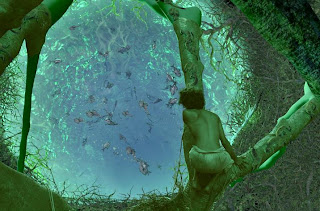Neatly
arranged rows of brightly-coloured panels greet the eye, offset against the
surgical theatre whiteness of the walls of the gallery. There’s an apparent
science to these images that pay painterly homage to nature. “The New Hortus
Malabaricus” is German artist Wilhelm Bronner’s contemporary reinterpretation
of a seventeenth century botanical treatise which contains the first block-printed
evidence of Konkanni in Devanagiri. Bronner was on hand to converse with
visitors to the Sanskruti Bhavan art gallery at the Krishnadas Shama Central
Library where his work was displayed between 19th and 23rd
February, 2013. The exhibition was organized by the Government of Goa’s
Directorate of Art and Culture.
The
original Hortus Malabaricus catalogued
742 plants from the Malabar Coast. Comprising of twelve volumes with
descriptions in Latin, Malayalam, Arabic, and Konkanni, it was published
between 1608 and 1703. The Konkanni contribution came from the physicians Ranga
Bhat, Vinayak Pandit, and Appu Bhat who were part of the team that worked on
the compilation, connoting a cultural and linguistic connection to Goa within
the annals of the history of science.
Bronner’s
take on the Malabaricus revisits
colonial history and the power relations inherent in classification projects. In
the exhibition notes, the artist states: “The scientific work has to be seen as
an unusual cooperative work between the Dutch invadors [sic] and the local
people. Over a period of 20 years Adrian Van Rheede, Govenor [sic] of Cochin
and the Malabar Coast and Itty Atchuthan, head of the local Brahmans were
constantly working together.” What made such an association “unusual”? The
Dutch bested the Portuguese in Cochin in 1663, evidencing the linked histories
of the European colonization of the Malabar Coast and Goa. However, the collaboration
between the Dutch and the native elite, even if in the confines of a colonial
hierarchy, speaks to the perpetuation of institutionalized authority. For the
Dutch, Bronner muses, the Malabaricus mission
provided knowledge of local medicinal flora, guaranteeing their health in a
foreign land. Likewise, their native counterparts offered expertise which assured
their own status would not be destabilized, Bronner adds.
Not without
whimsy, the artist’s twelve comical versions of a classical illustration from
the older Malabaricus render a
genteel European and her infantilized attendant labourers in flamboyant colour.
This irreverent departure from the solemn black and white of the Early Modern period
paints the picture anew. It invites viewers to look at the botanical project
for how it parallels the ordering of plants and human interactions in the
convergence of science and art amidst the multiple hues of history.
The print version of this article, with many unapproved alterations, appears here. See Wilhelm Bronner's website here.






